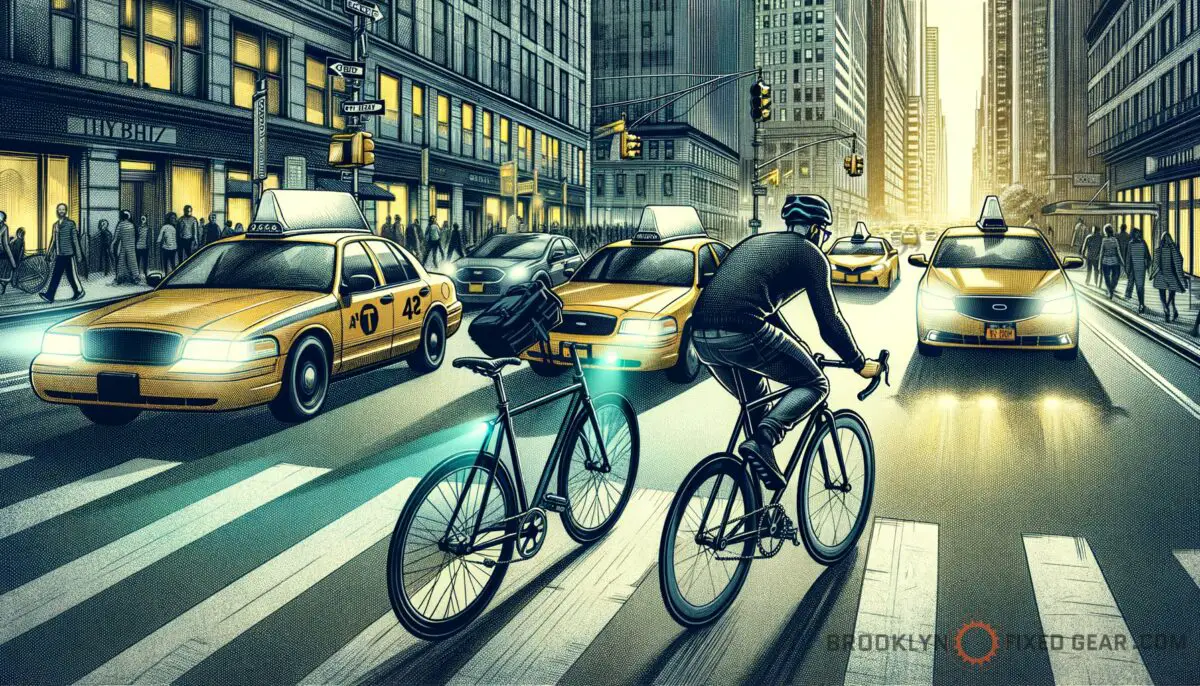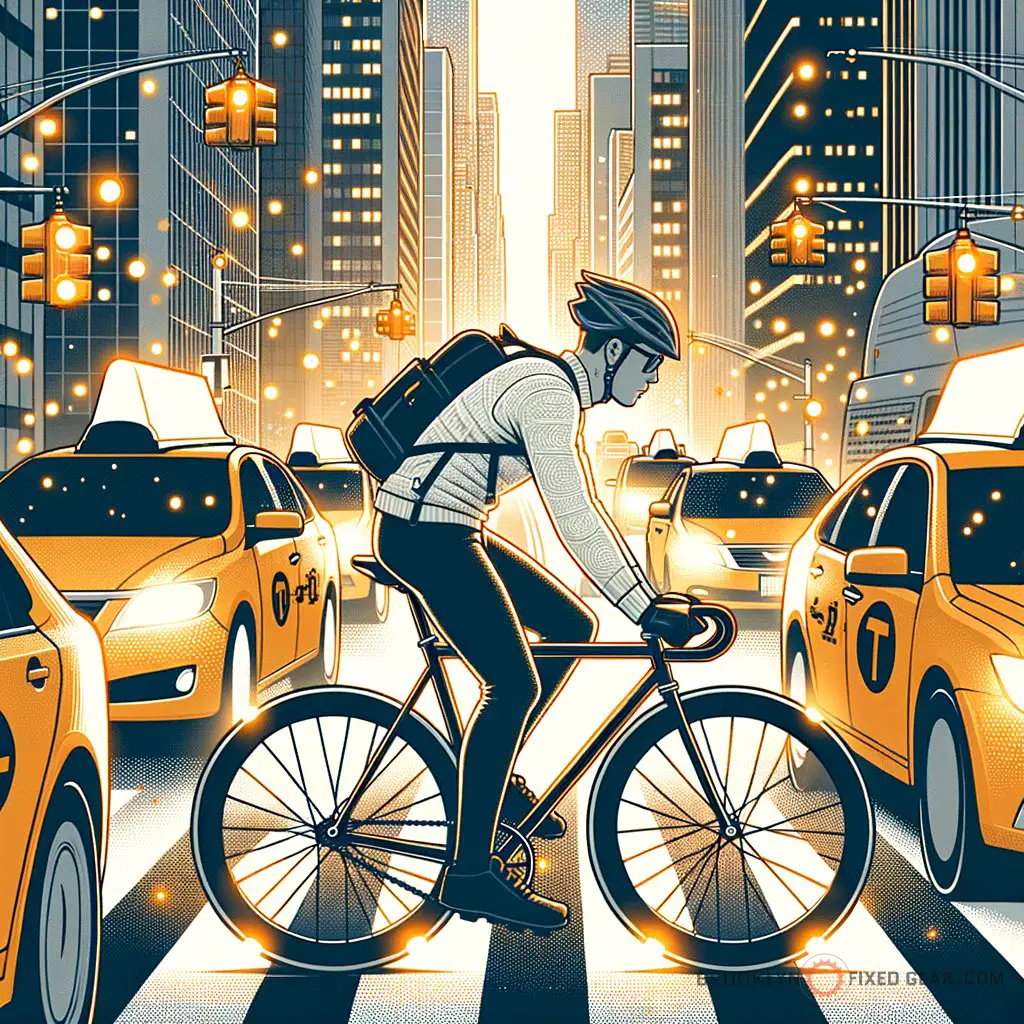Ever wondered how to cut through the urban jungle on your fixie without breaking a sweat or, more importantly, your bones? Check out how to glide through the city maze with confidence on some of the best fixie bikes.
In this post, we cover essential tips for staying safe while navigating traffic on your urban cycling adventures.
Key takeaways
- Visibility and vigilance are key to urban cycling safety.
- Riding a fixie in traffic requires specific skills and awareness.
- Defensive cycling can significantly reduce the risk of accidents.
When you’re cutting through the concrete labyrinth of New York on your fixie, staying alert is your first line of defense. Always keep an eye out for those unpredictable yellow cabs and swiftly opening car doors. It’s a concrete jungle out there, and any seasoned cyclist knows that unpredictability is the only predictable thing about urban cycling.

Visibility is your best ally when it comes to traffic. Deck out your ride with the brightest lights and slap on some reflective tape to make sure you’re seen. Remember to stay lit like Times Square, no matter if it’s high noon or a moonless night.
That’s one of the top-notch tips for outfitting your bike.
Bullet your way through traffic with these pointers:
- Start every ride with the mindset of an underdog boxer—hungry and defensive. Watch for those jaywalking pedestrians, the blind spots of buses, and those sneaky potholes waiting to throw you off your rhythm.
- Hand signals are not just polite gestures; they’re your dialogue with the motorheads around you. Clear signals can prevent a world of hurt, so communicate like you’re on a first date—clearly and usually.
- Equip yourself with the right gear. A reliable bike multi-tool is essential for those unexpected roadside tweaks—it’s like a Swiss Army knife for your beloved two-wheeler.
Riding in the city isn’t just about dodging cars and pedestrians; it’s a symphony of actions, and your fixie is your instrument. From the way you navigate those hairpin turns, to sidestepping unforeseen obstacles, it all boils down to harmony between rider, bike, and the bustling streets.
Opinion time, people. I’m no high-flying bicycle attorney, but I’ve seen enough to say that common sense usually makes the best helmet—figuratively speaking, of course. Still, always wear an actual helmet.
I’ve heard from the grapevine, maybe you know about that scene from “Quicksilver” where Kevin Bacon weaves through traffic with the grace of a ballet dancer, and while it’s cool as heck, remember, Hollywood has stunt doubles and editors. In the real Big Apple, you only get one take—make it a safe one.
Remember, cycling’s not just about speed; it’s about the journey and coming back in one piece. So when you’re spinning your wheels, think of it like you’re painting your path on the canvas of the city—strategically, with a dash of flair, but always with a keen eye on the big picture.
And if you ever need to brush up on advanced riding skills, you know where to find me. Stay safe, ride smart, and keep those pedals turning.
State Bicycle Co. Black Label 6061

State Bicycle Co. Black Label 6061
Key strategies for urban cycling safety
Urban cycling is thrilling, but with it comes the responsibility of ensuring your safety amidst bustling city traffic. The most important measures to take are about being visible and staying vigilant.
Always wear reflective clothing and make use of bike lights. This is crucial during nighttime rides but also helps during the day, especially in overcast weather. You can learn more about the importance of visibility for cyclists here.
Defensive riding techniques
Defensive cycling is not just smart; it’s a must. Anticipate the actions of others and make your moves observable and predictable.

- Assume you’re invisible to others and ride accordingly.
- Stay out of vehicle blind spots, especially near large trucks and buses.
- Learn some of the most effective defensive techniques to keep you safe in traffic.
Always follow the rules of the road
Riding predictably means obeying traffic signals, signs, and lane markings. By acting like a vehicle, you solidify your place in the traffic flow and help prevent dangerous misunderstandings with drivers.
How to ride predictably
- Signal all turns and check over your shoulder before changing lanes or turning.
- Keep to the right side of the lane, riding in the same direction as traffic, except when passing or turning left.
- For more about the rules of the road for cyclists, check out drive predictably.
Intersections pose significant risks for cyclists. Minimize these risks by practicing heightened awareness and clear communication with motorists.
Interacting with drivers at intersections
- Make eye contact with drivers before crossing.
- Signal your intentions early and position yourself visibly.
- You can find strategies for safely crossing intersections in busy cities here.
Enhancing urban cycling infrastructure
Supporting initiatives that promote cycling infrastructure improvements could save lives. Segregated bike lanes, cycling-friendly traffic signals, and bike parking can make a big difference.
The impact of a cyclist-friendly environment
- Advocate for more bike lanes and better road-sharing laws.
- Participate in community planning meetings.
- Engage with the cycling community for stronger representation.

Helmet safety and proper fitting
A helmet is a cyclist’s best friend in case of a fall or collision. It has to fit right to provide maximum protection.
Steps for a proper helmet fit
- Ensure a snug fit and correct strap adjustment.
- Always wear your helmet, no matter how short the trip.
- Check out helmet fitting steps to safeguard your rides.
Urban streets invite cyclists to weave through traffic, but that comes with a set of risks. To stay safe, follow traffic laws, make yourself visible, ride defensively, and always wear a properly fitted helmet. Each of these strategies could avert potential accidents and save lives.
Discover the details of urban cycling challenges and solutions in the data table below.
| Urban Cycling | Challenge | Solution |
|---|---|---|
| Visibility | Being seen by drivers | High-visibility clothing, reflective accessories, proper lighting |
| Defensive Riding | Anticipating others’ actions | Staying alert, signaling turns, avoiding blind spots |
| Navigating Intersections | Interaction with vehicles | Making eye contact, using hand signals, positioning carefully |
| Infrastructure | Lack of cycling space | Advocating for dedicated bike lanes and cyclist-focused design |
| Helmet Safety | Risk of head injuries | Choosing the right helmet, ensuring proper fit, always wearing it |
Stay lit like Times Square, no matter if it’s high noon or a moonless night. Visibility is your best ally in urban cycling. Always wear reflective clothing and make use of bike lights.
Critical factors and their corresponding solutions for urban cycling safety.
More urban cycling tips
To complement your urban cycling toolkit, these extra tips will keep you agile and informed on the streets. These insights are geared to boost your urban riding experience and promote safety.
- Routinely check your bike for any maintenance needs—especially brakes and tire pressure.
- Familiarize yourself with local cycling laws, which can vary from one area to another.
- Consider taking a cycling safety course to sharpen your skills and awareness.
- Join local cycling advocacy groups to stay updated on safety campaigns and infrastructure developments.
- Map out your route beforehand, considering traffic patterns and time of day.
When it comes to urban cycling, the dos and don’ts can steer you clear of trouble and make your rides smoother. Paying attention to these can have a huge impact on your daily commute or leisure rides.
| Do’s | Don’ts |
|---|---|
| Use bike lanes when available | Ride against traffic |
| Look over your shoulder before lane changes | Ignore traffic signals |
| Use bells or verbal signals when passing | Wear headphones while riding |
| Keep your bike locked when unattended | Forget to equip your bike with lights at night |
| Be respectful to pedestrians and fellow cyclists | Assume drivers can see you |
Guidelines for urban cycling to maximize safety and enjoyment.
Advantages and disadvantages of urban cycling
Urban cycling stands out as a resourceful and environmentally friendly mode of transportation. While it offers numerous benefits, there are also challenges to acknowledge.
Advantages
- Provides a cost-effective alternative to driving or public transit.
- Offers health benefits through physical exercise and stress reduction.
- Reduces carbon footprint and is better for the environment.
- Enhances access to urban areas where traffic congestion may limit cars.
- Can be faster than other modes of transportation in heavy traffic areas.
Disadvantages
- Risk of theft or vandalism when bikes are not properly secured.
- Exposure to road pollution and weather conditions.
- Limited or insufficient cycling infrastructure in many urban areas.
- Risk of accidents with vehicles due to close proximity and shared space.
- Potential difficulty in transporting items or gear compared to a vehicle.
If you are a visual learner, check out this video titled ‘How To Ride In A City | Bike Riding Tips For Busy And Urban Streets’
Frequently asked questions (FAQ)
Can I ride my fixie the same way I would a road bike in traffic?
Riding a fixie in traffic requires a specific set of skills due to the absence of gears and, typically, no freewheel. You must develop strong leg control to manage your speed and approach intersections with caution, as stopping suddenly is more challenging. Get comfortable with the unique handling of a fixed-gear bike in a safe space before venturing into traffic.
How important is tire choice for urban cycling?
Tires are crucial for managing the varied terrain of city streets. For urban cycling, choose tires with good puncture resistance and the right level of grip for pavement riding. It’s also worth considering tires that can handle a bit of rain if you’re in a city with unpredictable weather.
Is it safer to ride on the road or a bicycle lane in urban areas?
Wherever possible, it’s generally safer to ride in a bicycle lane because they’re designed specifically for cyclists. However, if a bike lane isn’t available, you should ride on the road, following the same rules as motorists. Always avoid sidewalks as pedestrians aren’t expecting fast-moving cyclists.
Final thoughts
Wrapping up, urban cycling is an art and a science, requiring a blend of precautions, savvy street navigation, and the right gear. It’s not just about getting from A to B; it’s about enjoying the journey in a safe and responsible manner. With the tips and strategies discussed, you’re better equipped to tackle the urban environment on two wheels.
Keep your wits about you, stay visible, and ride with confidence.
What’s your go-to tip for urban cycling that wasn’t covered here? Did I cover everything you wanted to know? Let me know in the comments section below I read and reply to every comment. If you found this article helpful, share it with a friend, and check out my full blog for more tips and tricks on urban cycling safety. Thanks for reading, and pedal on with pride and care!















